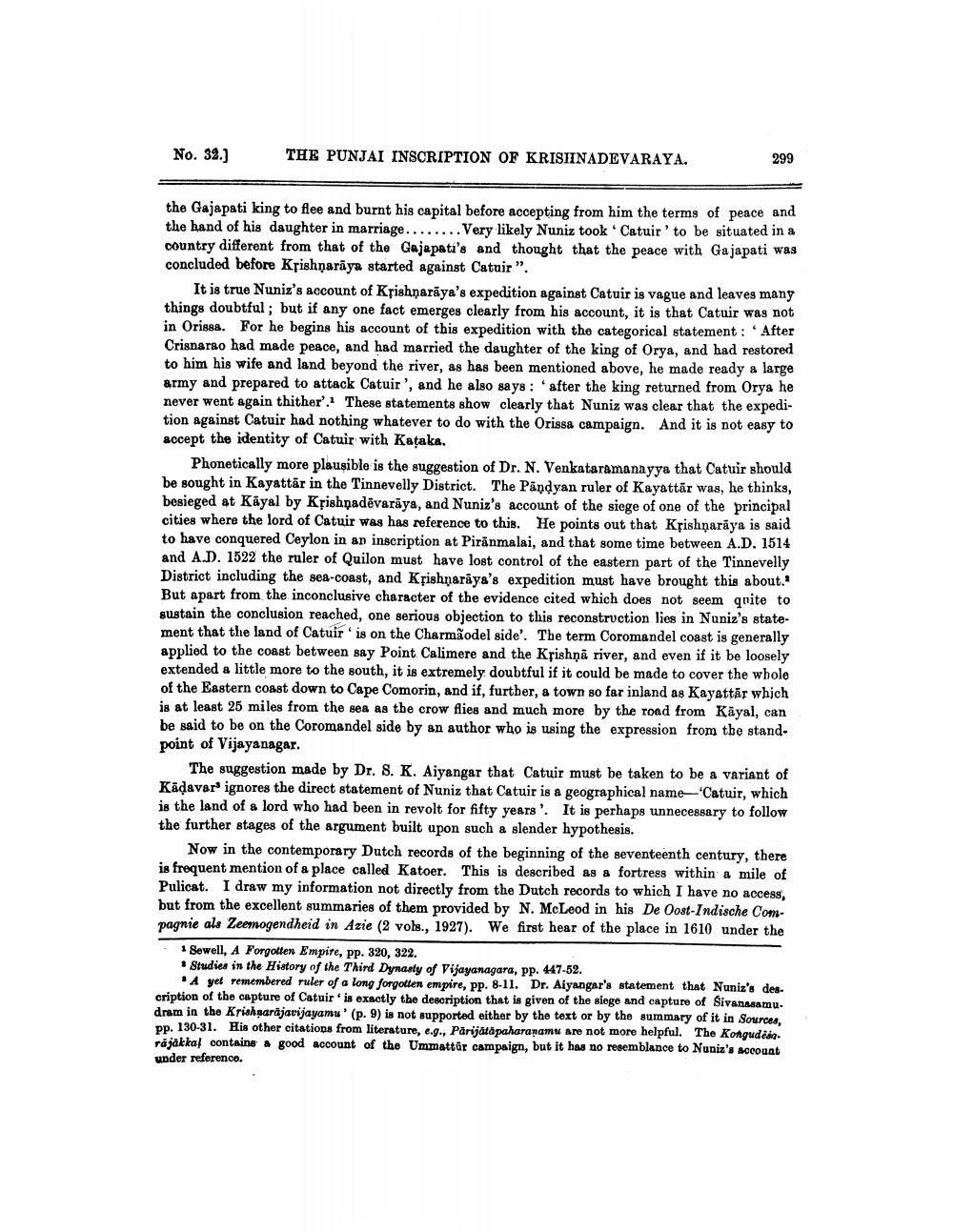________________
No. 32.]
THE PUNJAI INSCRIPTION OF KRISHNADEVARAYA.
299
the Gajapati king to flee and burnt his capital before accepting from him the terms of peace and the hand of his daughter in marriage........ Very likely Nuniz took Catuir' to be situated in a country different from that of the Gajapati's and thought that the peace with Gajapati was concluded before Krishnaraya started against Catuir ".
It is true Nuniz's account of Krishnaraya's expedition against Catuir is vague and leaves many things doubtful; but if any one fact emerges clearly from his account, it is that Catuir was not in Orissa. For he begins his account of this expedition with the categorical statement: After Crisnarao had made peace, and had married the daughter of the king of Orya, and had restored to him his wife and land beyond the river, as has been mentioned above, he made ready a large army and prepared to attack Catuir', and he also says: after the king returned from Orya he never went again thither'. These statements show clearly that Nuniz was clear that the expedition against Catuir had nothing whatever to do with the Orissa campaign. And it is not easy to accept the identity of Catuir with Kaṭaka.
Phonetically more plausible is the suggestion of Dr. N. Venkataramanayya that Catuir should be sought in Kayattar in the Tinnevelly District. The Pandyan ruler of Kayattar was, he thinks, besieged at Kayal by Krishnadevaraya, and Nuniz's account of the siege of one of the principal cities where the lord of Catuir was has reference to this. He points out that Krishnaraya is said to have conquered Ceylon in an inscription at Piränmalai, and that some time between A.D. 1514 and A.D. 1522 the ruler of Quilon must have lost control of the eastern part of the Tinnevelly District including the sea-coast, and Krishnaraya's expedition must have brought this about." But apart from the inconclusive character of the evidence cited which does not seem quite to sustain the conclusion reached, one serious objection to this reconstruction lies in Nuniz's statement that the land of Catuir is on the Charmãodel side'. The term Coromandel coast is generally applied to the coast between say Point Calimere and the Krishna river, and even if it be loosely extended a little more to the south, it is extremely doubtful if it could be made to cover the whole of the Eastern coast down to Cape Comorin, and if, further, a town so far inland as Kayattar which is at least 25 miles from the sea as the crow flies and much more by the road from Käyal, can be said to be on the Coromandel side by an author who is using the expression from the standpoint of Vijayanagar.
The suggestion made by Dr. S. K. Aiyangar that Catuir must be taken to be a variant of Kadavar ignores the direct statement of Nuniz that Catuir is a geographical name 'Catuir, which is the land of a lord who had been in revolt for fifty years'. It is perhaps unnecessary to follow the further stages of the argument built upon such a slender hypothesis.
Now in the contemporary Dutch records of the beginning of the seventeenth century, there is frequent mention of a place called Katoer. This is described as a fortress within a mile of Pulicat. I draw my information not directly from the Dutch records to which I have no access, but from the excellent summaries of them provided by N. McLeod in his De Oost-Indische Compagnie als Zeemogendheid in Azie (2 vols., 1927). We first hear of the place in 1610 under the
1 Sewell, A Forgotten Empire, pp. 320, 322.
Studies in the History of the Third Dynasty of Vijayanagara, pp. 447-52.
A yet remembered ruler of a long forgotten empire, pp. 8-11. Dr. Aiyangar's statement that Nuniz's description of the capture of Catuir is exactly the description that is given of the siege and capture of Sivanasamu. dram in the Krishnarajavijayamu' (p. 9) is not supported either by the text or by the summary of it in Sources, pp. 130-31. His other citations from literature, e.g., Pärijätäpaharaṇamu are not more helpful. The Kongudesa. rajakkal contains a good account of the Ummattur campaign, but it has no resemblance to Nuniz's account under reference.




